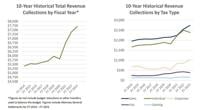(The Center Square) – The Consumer Price Index for the South Region is up 3.4% over the year through July, according to new data from the U.S. Bureau of Labor Statistics.
Data for July released on Thursday shows the Consumer Price Index for all urban consumers in the South Region rose 0.2% overall from June to July, driven in part by increased costs for energy and food, which were up 1.1% and 0.4%, respectively.
The index for all items less food and energy was up 5% from July 2022, while the food index increased 5.1% and energy costs fell 12.8% over the last year, the latter tied to a 20.1% decline in the cost of gasoline.
The 0.2% increase in July is only the second increase in the index for the South Region since inflation peaked at nearly 10% last summer.
“The CPI is based on prices of food, clothing, shelter, fuels, transportation fares, charges for doctors' and dentists' services, drugs, and other goods and services that people buy for day-to-day living,” according to BLS. “Each month, prices are collected in 75 urban areas across the country from about 6,000 housing units and approximately 22,000 retail establishments – department stores, supermarkets, hospitals, filling stations, and other types of stores and service establishments. All taxes directly associated with the purchase and use of items are included in the index.”
The South, as defined in Census regions and for purposes of this report, includes Alabama, Arkansas, Delaware, District of Columbia, Florida, Georgia, Kentucky, Louisiana, Maryland, Mississippi, North Carolina, Oklahoma, South Carolina, Tennessee, Texas, Virginia and West Virginia.
Over the last year, the biggest shifts came from the decline in gas prices, a 9.9% increase in rent, an 11.8% increase in transportation services, and a 6% decline in the cost of used cars and trucks.
The Consumer Price Index is one of many factors followed by the Federal Reserve as it considers another interest rate hike to cool the economy when it meets next month. The Federal Reserve increased the federal funds rate 0.25% in July to a target range of 5.25 to 5.5%, the 11th increase since March 2022. The new rate represents the highest benchmark borrowing costs in over two decades.
Federal Reserve Board Chairman Jerome Powell told reporters in July there remains “a long way to go” to return inflation to the 2% target set by the Federal Open Market Committee. Federal Reserve Governor Michelle Bowman said Monday at an event in Atlanta that an additional rate hike in September “will likely be needed.”
“Economic activity has grown at a moderate pace, and even as banks have been tightening their lending standards in response to higher interest rates and funding costs, lending to businesses and household has continued to expand,” Bowman said.
“I know that high inflation has been a hardship, especially for lower and middle-income families, who spend the majority of their income on necessities,” she said. “Returning inflation to 2% will help American families focus on important decisions other than inflation.”


































